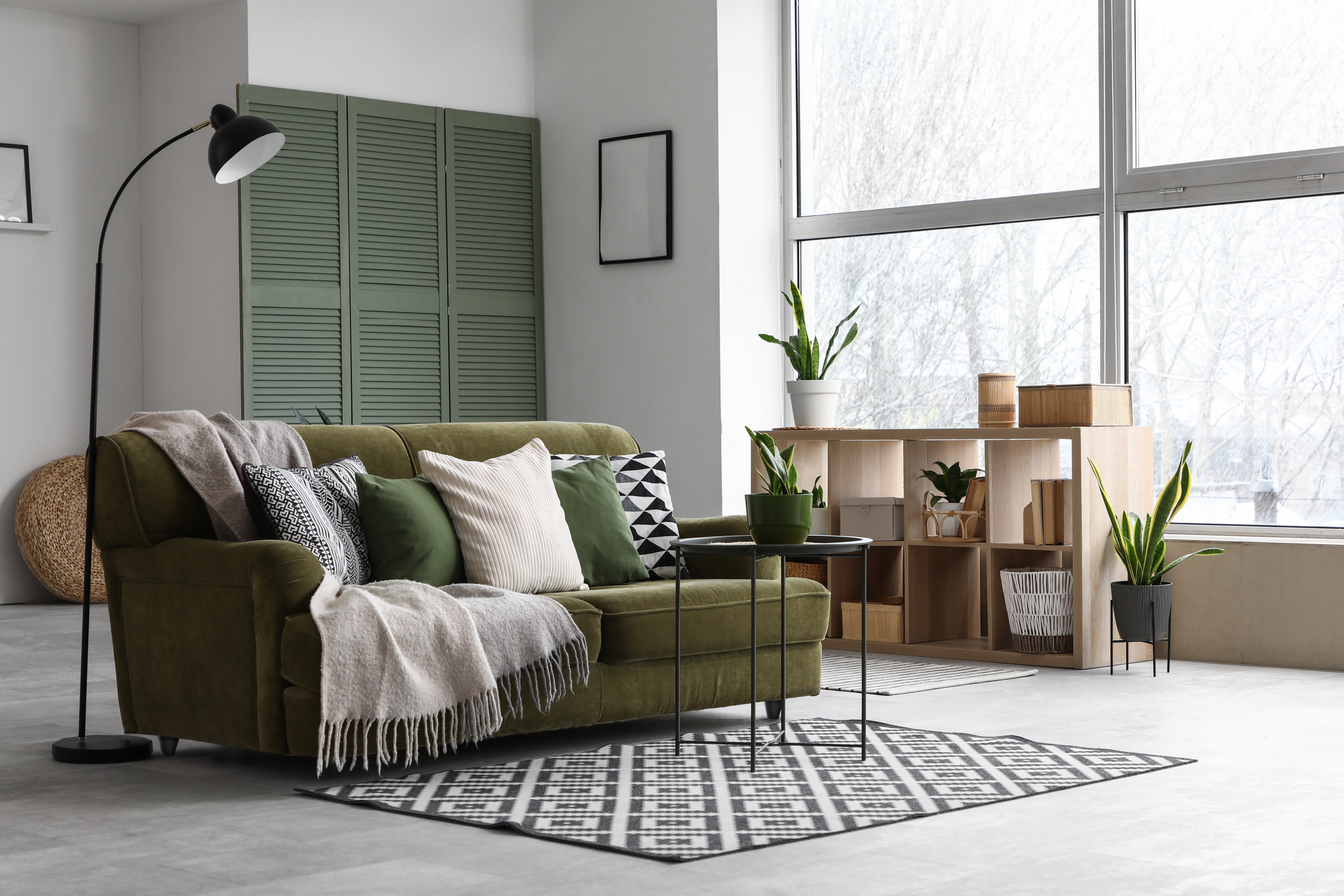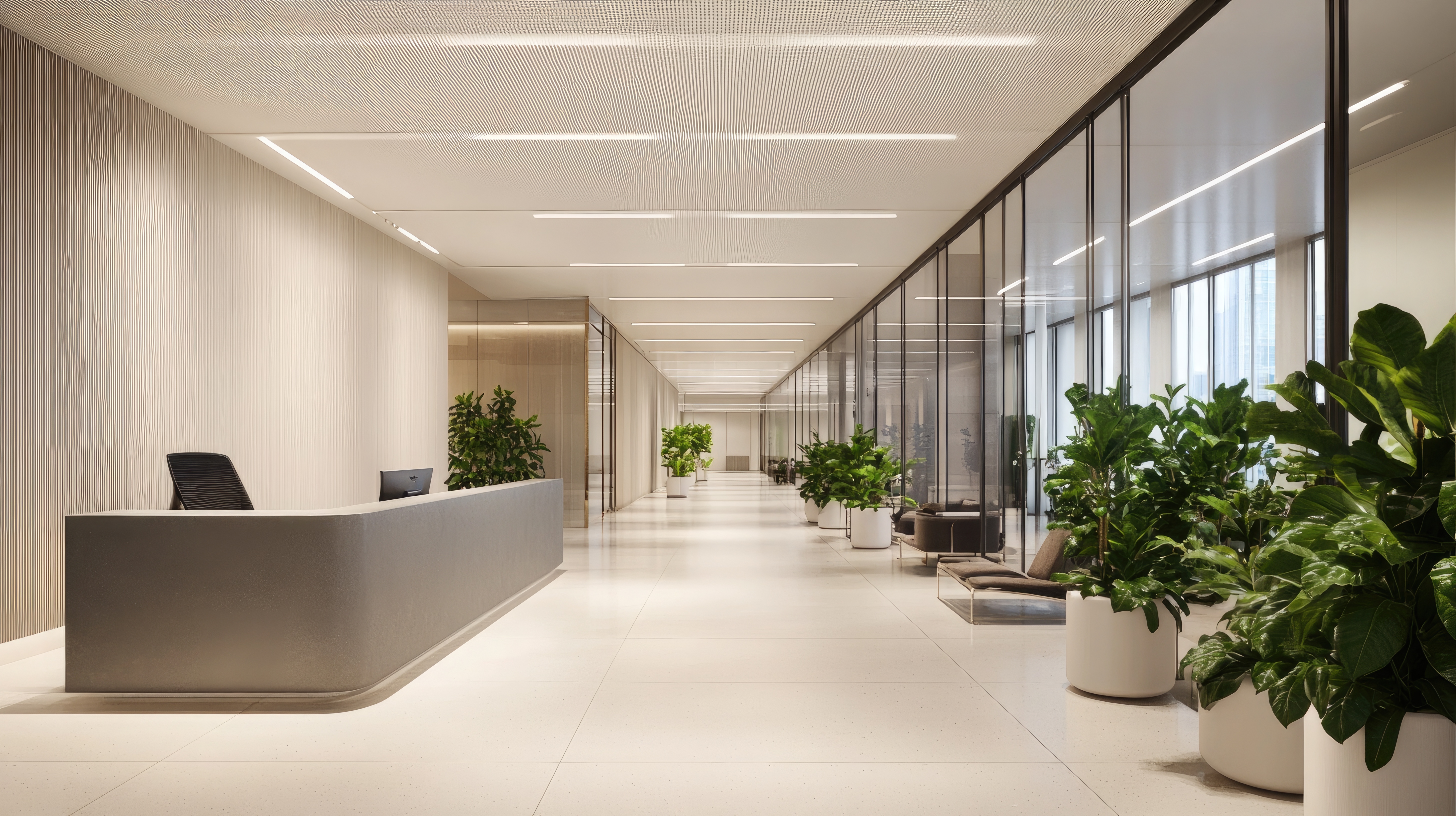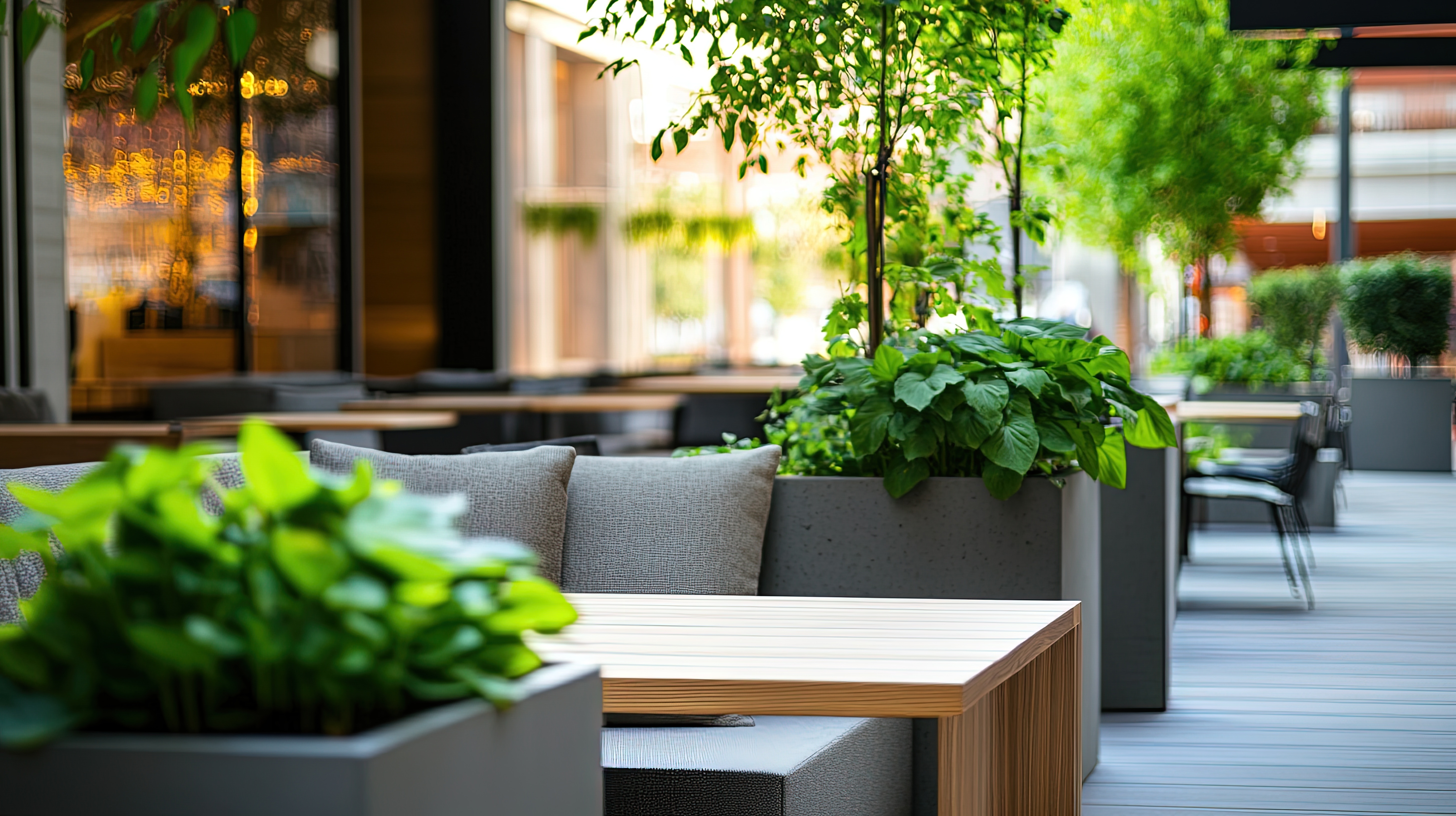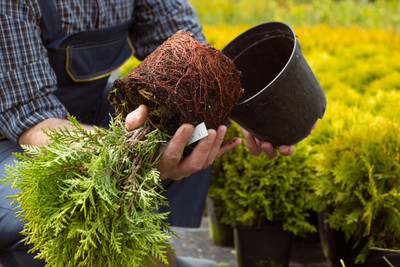Acoustics & Air-Quality: Using Planters as Functional Décor
Posted by Jason Wyrwicz on Jun 6th 2025

Walk into any modern café, co-working space, or hotel lobby and you’ll likely be greeted by an airy, open-plan layout bathed in natural light.
It looks calm at first glance, but there’s a catch: glass, polished concrete, and high ceilings bounce sound around like a pinball machine.
Conversations echo, background hum turns into noise fatigue. And those same stylish surfaces trap airborne pollutants, creating a mix of invisible stressors.
Strategic planting is the fix, not the dusty fake ficus in the corner, but real greenery placed in thoughtfully chosen fibreglass planters. This approach mutes noise, purifies the air, and elevates aesthetics - all without looking like you’ve dragged the garden indoors. Let’s break down how.
Why Acoustics Matter in Functional Office Decor
If you’ve ever struggled to concentrate in a buzzing open-plan office or felt drained after coffee in a busy café, acoustics may be to blame. When hard surfaces dominate a space, sound waves reverberate more, muddling speech and creating mental strain.
The World Health Organization recommends keeping noise levels under 35 dB in office environments. Yet most modern interiors easily exceed that.
Reverberation - how long a sound persists after its source stops - affects our ability to understand speech. The longer it lingers, the harder it is to follow conversations. That extra effort to listen drains mental energy and raises stress levels.
And it’s not just discomfort. Poor acoustics can hinder productivity, affect customer experience, and create subconscious agitation. That’s where plants come in.
Plant Science & Sound Absorption

Plants help soften a space not just visually, but acoustically too. Their leaves scatter high-frequency sounds, while their structure (including stems and soil) absorbs mid-range frequencies.
A study published in ScienceDirect tested a room outfitted with a living wall and found a reduction of up to 15% in reverberation time. That’s a significant drop, especially when scaled across larger, echo-prone interiors.
So, how does this work exactly? Several factors affect how well plants absorb sound:
- Leaf area index - The bigger and denser the leaves, the more they can catch and scatter sound waves. Think of it like a natural sound net: the more leaves, the more chances sound gets broken up before it bounces around.
- Plant height - Taller plants are especially helpful because they absorb noise right at the level where people talk. Since most conversations happen around mouth height, having plants that reach this zone can significantly reduce the harshness of voices and nearby sounds.
- Grouping density - Just like how a forest is quieter than a single tree, grouping plants closely together creates thicker, layered barriers. These clusters form varied surfaces that prevent sound waves from bouncing straight back, softening echoes more effectively than a lone plant could.
- Planter material thickness - Planters made from thick materials, like fiberglass, can absorb lower-frequency vibrations that plants alone might miss. This extra layer helps muffle deep hums and rumbles, adding to the overall quietness of the space.
Here’s a quick comparison of common indoor plants and their noise-reduction potential:
| Plant | Noise Reduction Coefficient* | Best Use |
|---|---|---|
| Fern | 0.15 | Corner clusters |
| Peace Lily | 0.12 | Desktop/shelves |
| English Ivy | 0.10 | Hanging setups |
| Ficus Benjamina | 0.18 | Floor planters |
*Values based on averaged estimates from acoustic lab tests via ResearchGate and Scilit.
Plants & Indoor Air Quality: What the Research Really Says

We often hear that plants purify air, thanks largely to a 1989 NASA study. That research showed plants could remove VOCs like benzene and formaldehyde from sealed chambers. The most effective were peace lilies, snake plants, and pothos.
But modern reviews have added nuance. According to the American Lung Association, to truly impact indoor VOC levels in a standard office, you’d need somewhere between 10 and 1,000 plants per square meter. That’s not exactly practical.
Still, don’t write off greenery just yet. Plants offer realistic and valuable benefits:
- Modest VOC uptake in smaller, enclosed spaces: In contained environments - like meeting rooms or private offices - a few strategically placed plants can help reduce low levels of airborne toxins.
- Humidity regulation - Plants release moisture through transpiration, which gently boosts humidity levels. This can ease dry skin, irritated eyes, and respiratory discomfort, especially helpful in air-conditioned interiors.
- Microbe diversity boost - Introducing plants can enhance the microbial mix in indoor air, adding beneficial bacteria that may support immune health. A feature in The Washington Post explored how this subtle biodiversity shift can positively impact the indoor biome.
Have a look at this helpful snapshot of top-performing air-purifying plants, ideal planter size, and required care level:
| Plant | Ideal Planter Size | Care Level |
|---|---|---|
| Snake Plant | 10–12 inch pot | Low |
| Peace Lily | 12–16 inch pot | Medium |
| Areca Palm | 14+ inch floor pot | Medium |
| Spider Plant | 8–10 inch pot | Low |
| Pothos | Hanging or 8 in pot | Low |
| Rubber Plant | 12–18 inch pot | Medium |
| ZZ Plant | 10–12 inch pot | Low |
| Bamboo Palm | 12+ inch planter | Medium |
Designing Dual-Purpose Planter Layouts

To get the most out of your indoor greenery, layout matters. You’re not just decorating - you’re designing zones, diffusing sound, and subtly reshaping how people interact with space.
- Zone noisy areas - Place 36-inch long planters next to printers, corridor bends, and café seating. These extended, low-profile containers act as soft dividers and help to intercept and dampen noise before it spreads.
- Layer heights - Combine 18-inch cubes with 48-inch tall planters to form multi-level plant zones. This height variation targets a broader spectrum of frequencies - taller plants intercept sound at conversation level, while shorter ones manage ambient reverberation closer to the floor.
- Create green “baffles” - Along echo-prone surfaces like glass walls or marble partitions, stagger three planters around 18 inches apart. This arrangement disrupts direct sound reflection and creates a more acoustically comfortable experience without obstructing visual lines.
- Encourage natural movement - Well-placed rectangular planters can also guide foot traffic or softly delineate collaborative spaces. For example, a row of plants can carve out a lounge nook in a lobby or soften transitions between open and private zones.
Why Fiberglass Planters Excel in Functional Decor

The container matters almost as much as the plant. While ceramic, plastic, and metal planters might be popular for their finishes, fiberglass offers key advantages that make a real difference in both air quality and sound control.
- Lightweight but sturdy - Fiberglass planters are easy to move, even the larger ones. That means you can reposition them as needed - whether you're adjusting for seasonal sunlight or trying to quiet a new noise source.
- Thick yet slim walls - Unlike thin plastic or tinny metal containers, fiberglass has a dense structure that helps absorb vibrations. The walls are thick enough to reduce sound but don’t take up unnecessary floor space.
- Non-porous surface - Because fiberglass doesn’t absorb water, there’s less chance of mold or mildew forming in the planter. This is especially important for air quality, since you don’t want to introduce new irritants indoors.
- Durable and low-maintenance - Fiberglass doesn’t crack or warp easily, even in busy spaces. It’s a long-term investment that stands up to wear without looking tired after a year or two.
- Neutral and modern finishes - These planters match most interiors, whether you’re styling a stylish office or a warm café corner. You get function and form in one neat package.
Popular choices from our range include the slim Amesbury Rectangular Planter, which is ideal for tight or narrow spaces like walkways and corridors. Its long, narrow shape lets you add greenery without blocking movement or crowding the area.
Another favourite is the self-watering Saint Tropez Tall Vase Planter. These planters are perfect for busier spots - think office lobbies, co-working spaces, or busy café corners - where regular plant care isn’t always possible.
Maintenance & Health Checklist
Green spaces only work if they stay healthy, and a little regular care goes a long way. Here’s how you can keep your planter zones vibrant and effective:
- Dust leaves weekly - Clean leaves help plants “breathe.” Removing dust keeps stomata (the tiny pores on leaves) clear, as well as improves air filtration and allows efficient gas exchange.
- Rotate planters monthly - This will prevent one side from growing faster due to sunlight or airflow. Balanced growth will also ensure even sound absorption across the room.
- Use low-VOC potting mix - Standard soils can off-gas chemicals over time. Choose low-VOC options to protect indoor air quality from hidden contaminants.
- Top-dress with coconut coir or moss - Putting a layer of coconut coir or moss on the soil helps keep moisture in and stops mold from growing. It also makes your planter look nice.
- Replace under-performing plants every 12–18 months - If a plant is struggling despite good care, it may no longer serve its purpose, whether it’s filtering air or absorbing sound. Swap it out for a healthier one to keep your setup thriving.
Elevate Your Functional Decor Ideas with Fiberglass Planters
Modern urban interiors need more than great lighting and stylish furniture. They need softness, calm, and quiet. Greenery in the right planter can provide all three, and fiberglass makes it easy.
Whether it’s an echo-heavy lobby or a noisy open-plan office, smart placement of fiberglass planters filled with air-boosting and sound-softening plants transforms a space from hard-edged to harmonious. As a result you get clearer conversations, a calmer mind, and a more grounded atmosphere that feels as good as it looks.
On top of that, fiberglass planters are lightweight, elegant, and incredibly durable - perfect for spaces that need to be flexible without sacrificing style. Whether you’re staging a meeting zone or carving out a quiet lounge corner, they help define space without blocking flow.
Ready to trial a sound-softening, air-kind planter setup? Explore our full fibreglass planter range and transform your interior into a healthier place.



